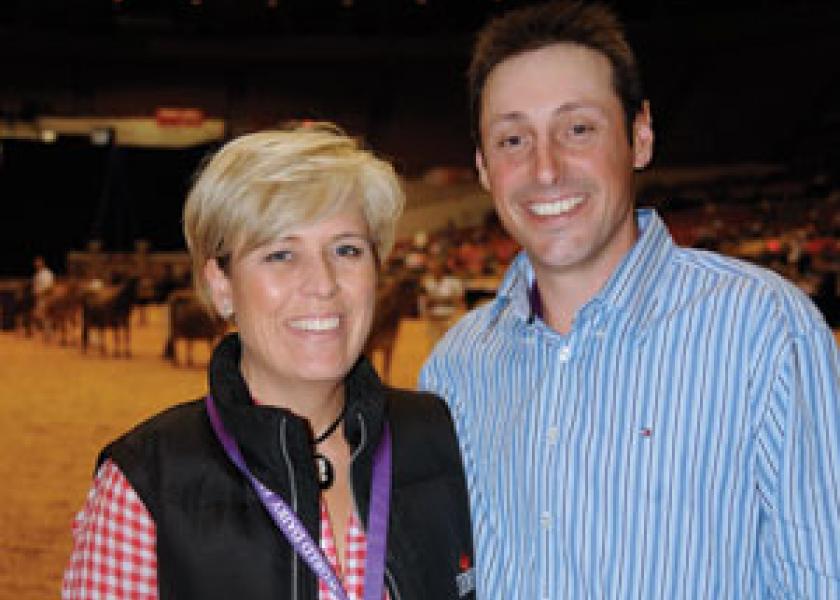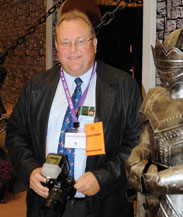Journalists on the Job

The world’s premier dairy show is big news from Australia to Switzerland and beyond
The physical location of the event might be North America, but the goings-on at World Dairy Expo are of keen interest to dairy farmers and others connected with the industry all over the world.
To satisfy the global hunger for news and information relating to the world’s premier dairy show, editors and news directors for international media outlets routinely dispatch their best reporters, anchors and camera crews to Madison, Wis., each fall to capture the sights, sounds and stories of World Dairy Expo.
Extreme coverage. Husband-and-wife team Dean and Di Malcolm of Shepparton, Australia, are among the members of the international press corps attending Expo on a regular basis. The Malcolms are the publishers and editorial staff of Crazy Cow in Print, a full-color, glossy, all-breed magazine with subscribers in 15 countries.
"Our basic approach while we’re here is to delve into stories about the people who are involved in the different breed shows," Di says, noting that she and her husband launched their publication in 2004 as a companion enterprise to the www.crazycow.com.au website. The couple also owns Bluechip Genetics, a 120-cow, all-breed dairy farm.
"There are a lot of people from Australia, where most of our readers are concentrated, who would like to be at Expo, but can’t. They can see photos, videos and results online," Di says. "For the magazine, we look to go behind the scenes and talk to the winners to find out what the drama was before they stepped into the ring, what kind of problems they might have encountered with the cows, what kind of other obstacles they faced and so on."
Coverage of last year’s event in the Malcolms’ print edition included a story on Rudolph, Wis., breeders Mike and Julie Duckett. The Ducketts are part of the ownership team for Harvue Roy Frosty, the Holstein cow that captured Supreme Champion honors at Expo in 2009 and 2010. The story spanned four pages and focused on what winning the title has meant for the Ducketts and their genetics marketing campaign. Frosty was also featured on the cover of that particular issue.
In the same issue, the Malcolms ran a story on a young Australian breeder who purchased a cow from a U.S. and Canadian partnership for $56,000, a profile of one of the co-owners (Denise Riddle) of the Intermediate Jersey Champion and a feature on U.S.-based cattle photographer Frank Robinson. They also devoted three pages to comments from and photographs of Australians attending Expo, plus another two pages to results and photographs from the Expo show ring. In one of their follow-up issues, they did a story on Tom Morris, the Amery, Wis., auctioneer who has been overseeing Expo’s World Classic Holstein Sale since 1989. Morris is also the publisher of the Cattle Connection, a monthly newspaper devoted to registered dairy cattle marketing.
"I guess some might call what we do at Expo ‘extreme coverage,’" Di says. While she and Dean used to come to Expo annually, they now make the trip just once every other year to save money on travel costs. "In fact, we had one subscriber cancel his subscription because he thought we had too much U.S. material. But the way we look at it, World Dairy Expo is the cutting edge of the world dairy genetics market, and we treat it as such," she adds.
"Among our readers, there’s a tremendous amount of interest in American genetics," Dean says. "At this show, we have access to the leaders and the innovators, the people who make the industry tick. For that, World Dairy Expo is the absolute best dairy show anywhere in the world. There’s nothing else like it."
Focus on genomics. Swiss agricultural journalist Rudolf Haudenschild serves a different kind of audience. He’s the editor-in-chief of Schweizer Bauer, a twice-weekly agricultural newspaper with approximately 33,000 readers in eastern Switzerland. He made his first trip to Expo in 1992 and has returned once every two to four years. In 2009 and 2010, he made back-to-back trips to the event.
"The typical farm in Switzerland is a mixed farm with crops and animals, mostly milk production," he explains. "The newspaper emphasizes market news, trends and analysis that will help our readers make marketing decisions. But we also provide technical help. We present the newest ideas on how to feed and milk animals, how to breed cows and how to grow crops."
 |
| Rudolf Haudenschild’s agricultural newspaper Schweizer Bauer emphasizes news, trends and analysis to help his Swiss readers make marketing decisions. |
The seemingly nonstop dairy cattle breed shows are the focal point of Haudenschild’s Expo coverage. "There is a lot of interest among our readers in North American genetics," he says. "I spend time here with the show judges, the AI people, sire analysts and the breeders. I try to find out what the latest trends are—which bulls are making the show cows, which cows are catching everyone’s attention and so on. This is a great place to get at that kind of information. In one place, you can have discussions with people from the whole industry in a very short period of time."
During his last two trips to Expo, Haudenschild has also spent a fair amount of time covering developments in the emerging scientific field of genomics. "It’s a topic that everyone seems to be talking about, and we are sure it will change the whole dairy industry and all of agriculture," he says.
"When I came here in 2009, there was an hour-long discussion of genomics featuring speakers from the University of Wisconsin and also from Iowa. It was absolutely great," Haudenschild adds.
After the formal presentation, Haudenschild had a chance to interview the presenters in depth. "They helped me translate the information so that it would be meaningful for farmers. They explained in detail what the impact of genomics would be for individual farms and talked at length about the opportunities and the risks. When I came back last year, I met with more experts in the field and updated our readers on the latest developments."







